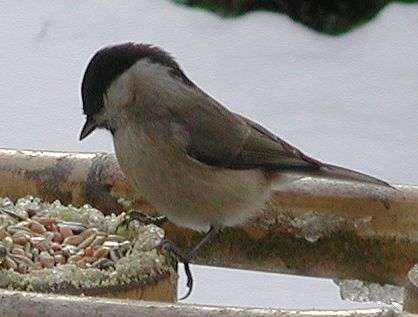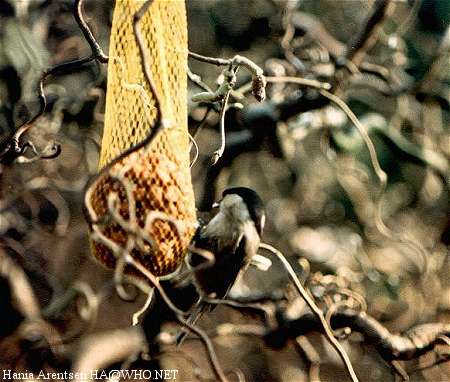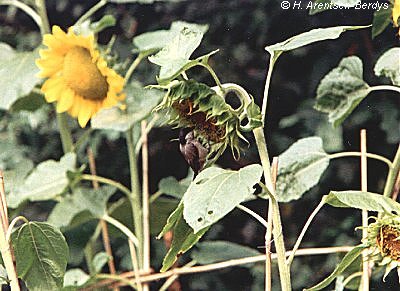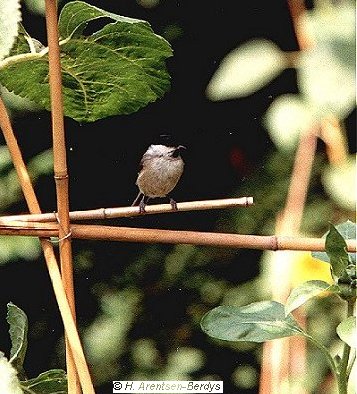Marsh Tit (Parus palustris)
Click![]() here for the bird's sound.
here for the bird's sound.

The Marsh Tit is not very colourful, but looks rather elegant.
This tit is about as big as the Blue Tit, but is less colourful. It appears as soon as you put food in your garden and is as acrobatic as the other tits. In summer you will hear the bird rather than see it. In spite of the fact that it's only colours seem to be grey, brown and black it's a magnificent bird, especially because of the large, almost glistening cap. Of course it may happen that you provide a bird with food when you do not want to. That happened one year when we planted in our garden lost of sunflowers. We wanted to gather the seed to provide the birds with something extra. Aren't we goodhearted? The seeds however never got the chance to fully develop, because the Marsh Tit considered this to be a feast as you can see in the picture below.

Like most titmice the Marsh Tit is not shy at all.
One time I wanted to surprise the Marsh Tit and other birds with the heads of sunflowers . SoIi grew them in the garden. As you can see in the pictures most of the seeds didn't last till winter. The Marsh Tit ate them even before they were fully ripe. So I gave up. I gave up on more fruits, for once I had strawberries, which were all eaten by blackbirds and squirrels. Blackbirds and Starlings also prevent me from harvesting cherries and blackbirds even like red currants when they are still extremely sour. So I gave up on all gardening experiments. Some currants and cherries remain in our garden, just for the birds to eat.


The Marsh Tit discovered my sunflowerheads even before the seeds were ripe.
This bird belongs to the family of Chickadees or Titmice (Paridae). It is common in our garden and being a resident bird it can be seen in Holland all year round. The bird is 4" and weighs 11 grams. It lives in woodlands, parks and gardens mostly. It eats insects and seeds. The sexes do not differ from one another. It makes a nest in a hole in a tree in april or may. Seven o eight eggs are deposited. They will be bred for 12 days, after which the young have to be taken care of in the hole for some 18 days. It is very hard to tell this bird and the Willow Titmouse (Poecile montanus) apart.
| Name of this bird in other languages | ||||
| Dutch | German | French | Polish | Scientific |
| Glanskopmees | Sumpfmeise | Mesange nonnette | Sikora uboga | Poecile palustris* |
* This species used to be known as Parus palustris, but has recently been placed in a new genus called Poecile.

© Copyright 1998-2024 gardensafari.net (Hania Berdys)

 English / engels
English / engels  Dutch / nederlands
Dutch / nederlands